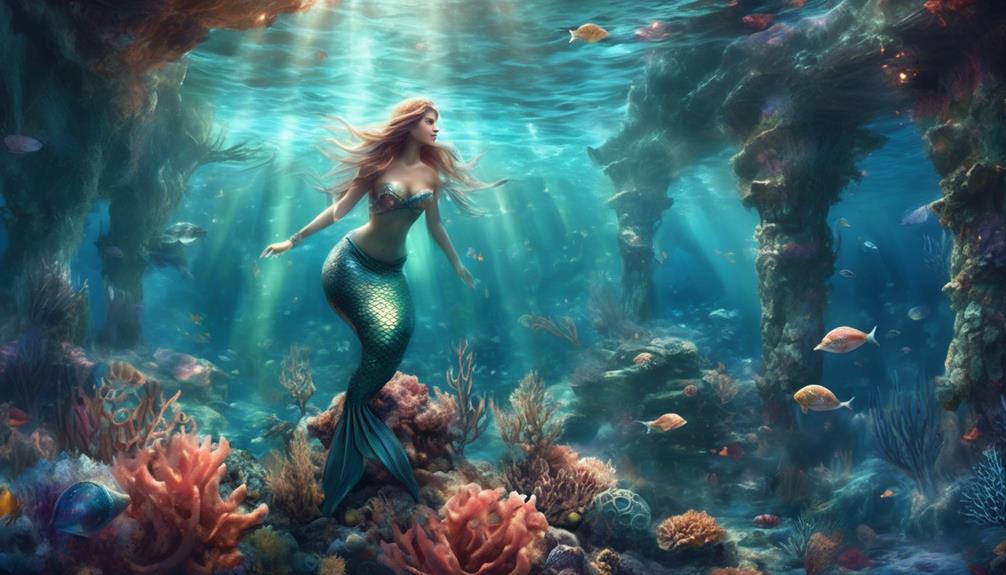Mermaids, often dismissed as mere folklore, actually play a crucial role in the delicate balance of marine ecosystems. Their significance reaches far beyond the realms of mythology and fantasy.
From their mythological origins to their ecological interactions, the presence of mermaids has far-reaching implications for the health and sustainability of our oceans. Understanding the impact of these legendary creatures on marine ecosystems provides valuable insights into the intricate web of life beneath the waves.
Key Takeaways
- Mermaids have significant mythological and cultural significance, reflecting societal values and desires.
- Mermaids' biological adaptations provide insights into potential evolutionary pathways for human adaptation to aquatic environments.
- Mermaids play ecological roles as predators and in symbiotic relationships, impacting marine biodiversity and food web structure.
- Conservation efforts should balance human fascination with mermaids and the need to protect their environment, requiring interdisciplinary collaboration and research.
Mythological Origins
The mythological origins of mermaids can be traced back to ancient civilizations and folklore, where they were often depicted as enchanting creatures with the upper body of a human and the lower body of a fish.
In historical context, mermaids appeared in the folklore traditions of various cultures, including the ancient Greeks, Syrians, and Africans. These mythical beings were often associated with perilous maritime events, luring sailors with their captivating songs and beauty.
The folklore surrounding mermaids also reflected societal attitudes towards female autonomy and the unknown depths of the sea. Studying the historical context and folklore traditions of mermaids provides valuable insights into the intersection of human imagination, cultural beliefs, and the marine environment.
Understanding the enduring allure of mermaids can offer unique perspectives on the human relationship with marine ecosystems.
Cultural Significance
Across diverse cultures, mermaids have maintained a significant and enduring presence in art, literature, and folklore, reflecting their profound impact on societal beliefs and perceptions.
The cultural symbolism of mermaids is evident in the diverse artistic representations found across civilizations, depicting them as both enchanting and ominous beings. These artistic representations often serve as reflections of societal values, fears, and desires, providing insights into the cultural significance of mermaids.
The allure of mermaids in art and literature has transcended time and continues to captivate audiences, highlighting their enduring impact on human imagination and creativity.
Understanding the cultural significance of mermaids is essential in comprehending their pervasive influence on societal narratives and the enduring fascination with these mythical beings.
Biological Adaptations
Mermaids' enduring presence in cultural narratives prompts an exploration of their biological adaptations, shedding light on the scientific basis for their mythical characteristics. The evolutionary advantage of mermaids' aquatic traits, such as streamlined bodies and enhanced lung capacity, suggests a potential link to human aquatic ancestors.
These adaptations would have conferred an environmental impact, enabling mermaids to thrive in diverse marine ecosystems. Their webbed hands and feet are indicative of an aquatic lifestyle, potentially aiding in swimming and diving. Additionally, the presence of gills or a modified respiratory system could have facilitated underwater respiration.
Understanding these biological adaptations not only contributes to the allure of mermaid folklore but also provides valuable insights into the potential evolutionary pathways of human adaptation to aquatic environments and their broader environmental impact.
Ecological Interactions
Ecological interactions within marine ecosystems reveal the significant impact of mermaids on the dynamics of aquatic communities.
As predators, mermaids play a crucial role in regulating the population of various marine species, thus influencing the predator-prey dynamics within these ecosystems. Their hunting patterns and prey preferences contribute to shaping the abundance and distribution of marine organisms, ultimately impacting the overall biodiversity and food web structure.
Additionally, mermaids are involved in symbiotic relationships with certain fish species, where they mutually benefit from each other. These interactions may include cleaning stations where mermaids remove parasites from fish, thus maintaining the health of certain fish populations.
Furthermore, mermaids might also rely on specific fish species for food, highlighting the intricate and multifaceted nature of their ecological relationships within marine ecosystems.
Conservation Implications
Upon evaluating the ecological impact of mermaids, it becomes evident that their conservation presents complex challenges due to their influential role in marine ecosystems.
The economic impact of mermaid-related activities, such as ecotourism and entertainment, raises concerns about the potential exploitation of their habitats. Conservation efforts must consider the delicate balance between human fascination with mermaids and the need to protect their environment.
Increasing public awareness about the importance of preserving marine ecosystems, including the habitats of mermaids, is essential. Education and outreach programs can help foster a deeper understanding of the ecological significance of mermaids and their interconnectedness with other marine species.
Food Web Dynamics
The complex interactions between mermaids and their marine environment significantly impact food web dynamics, shaping the ecological relationships among various species.
Mermaids, as top predators in some marine ecosystems, play a crucial role in predation dynamics and trophic levels. Their foraging activities can influence the abundance and distribution of prey species, thereby affecting the structure of the food web.
Additionally, mermaids contribute to nutrient cycling and energy flow within the ecosystem through their consumption and excretion processes. As they prey on lower trophic level organisms, they regulate the population dynamics of these species, ultimately impacting the entire food web.
Furthermore, the energy obtained from their prey is transferred up the food chain, influencing the overall productivity and stability of the ecosystem.
Understanding the role of mermaids in food web dynamics is essential for comprehending the broader ecological implications of their presence in marine environments.
Habitat Preservation
In assessing the preservation of mermaid habitats, researchers have observed the intricate interplay between environmental factors and the sustainable coexistence of these mythical creatures with other marine species. Preserving mermaid habitats is crucial for maintaining marine biodiversity.
Coral reef restoration plays a significant role in this effort, as these ecosystems are vital for mermaids and various marine organisms. Mermaids rely on coral reefs for shelter and as breeding grounds, making the restoration of these habitats essential for their survival. Furthermore, healthy coral reefs support a diverse array of marine life, contributing to the overall resilience of marine ecosystems.
Human Connections
Human interactions with mermaids have been a subject of interest and speculation, with various cultural, historical, and environmental dimensions influencing the dynamics of these connections.
The emotional resonance of mermaids within human societies has been a significant factor in shaping attitudes towards marine ecosystems. Psychological impacts stemming from the allure and mystery of mermaids have been observed to influence human behavior, particularly in coastal communities.
The psychological impact of these mythical creatures has been demonstrated in folklore, literature, and art, often portraying mermaids as guardians or protectors of the sea. This emotional and psychological connection to mermaids has the potential to foster a sense of stewardship and environmental responsibility towards marine ecosystems.
Understanding these human connections to mermaids is essential in comprehending the broader implications for marine conservation efforts.
Future Research
Undoubtedly, future research on mermaids and their impact on marine ecosystems will require interdisciplinary collaboration and innovative methodologies to address the complexities of human perceptions and behaviors towards the ocean environment.
Genetic studies will be essential in understanding the evolutionary history and genetic diversity of mermaid populations, shedding light on their potential role in marine ecosystems.
Additionally, environmental impacts resulting from human interactions with mermaids need thorough investigation to assess potential threats to marine biodiversity.
Behavioral observations will be crucial in elucidating the interactions between mermaids and other marine species, as well as understanding the role of mermaids in influencing human attitudes and behaviors towards ocean conservation.
Furthermore, population dynamics of mermaids, including their distribution and abundance, necessitate comprehensive research to evaluate their ecological significance and potential conservation implications.
Frequently Asked Questions
How Do Mermaids Impact the Tourism Industry in Coastal Areas?
Mermaids impact the tourism industry in coastal areas by creating economic benefits through increased tourism. Their mystique and allure draw visitors, leading to revenue for local businesses and communities, ultimately contributing to the economic growth of these areas.
Are There Any Known Cases of Mermaid Sightings or Encounters in Modern Times?
While mermaid sightings are often dismissed as hoaxes, they persist as a part of modern folklore. Scientifically, there's no evidence to support their existence, but they continue to capture the imagination and curiosity of many.
What Role Do Mermaids Play in Folklore and Storytelling Outside of Western Culture?
Mermaid symbolism and cultural significance extend beyond Western folklore, playing essential roles in various mythologies and storytelling traditions. Their portrayal reflects cultural beliefs and values, influencing art, literature, and societal perceptions of women and the sea.
How Do Mermaids Compare to Other Mythical Sea Creatures in Terms of Ecological Importance?
Mermaids, compared to other mythical sea creatures, hold significant ecological importance due to their impact on marine ecosystems. Their conservation, cultural representation, and potential for education programs make them a valuable focus for conservation messaging and tourism impact.
Are There Any Efforts to Incorporate Mermaid Imagery Into Marine Conservation Messaging or Education Programs?
Incorporating mermaid imagery in marine conservation messaging and education programs is gaining traction. Research suggests it can enhance public engagement, particularly in coastal areas, and mitigate the negative tourism impact on marine ecosystems.

